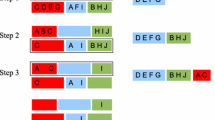Abstract
In this paper, we present a technique that applies genetic algorithm to the graph coloring problem. The algorithm described in this paper uses parallel genetic algorithm. The two algorithms running parallel are independent of each other. Both algorithms are using different fitness function. This results in higher chance of reaching the global optimum. The algorithm terminates after the desired solution is reached or after a fixed number of generations. This paper also tries to find the minimum number of colors that can be used to achieve such a condition that is the chromatic number of the graph using heuristic techniques. The proposed algorithm has succeeded at solving the sample data with high probability.
Access this chapter
Tax calculation will be finalised at checkout
Purchases are for personal use only
Similar content being viewed by others
References
Marx, D., Marx, D.A.: Graph Coloring Problems and Their Applications in Scheduling, John von Neumann PhD Students Conference, Budapest (2004); O’Madadhain, J., Fisher, D., and Nelson, T.: JUNG: Java Universal Network/Graph framework, 1 Oct 2011
Shengning, W., Sikun, L.: Extending traditional graph-coloring register allocation exploiting meta-heuristics for embedded systems. In: Proceedings of the Third International Conference on Natural Computation. ICNC, Haikou, pp. 324–329 (2007)
Hale, W.K.: Frequency assignment: theory and applications. Proc. IEEE. 12, 1497–1514 (1980)
Grefenstette, J.J., Baker, J.E.: How genetic algorithms work: a critical look at implicit parallelism. In: Proceedings of the Third International Conference on Genetic Algorithms, pp. 20–27 (1989)
Back, T., Hammel, U., Schwefel, H.P.: Evolutionary computation: comments on the history and current state. IEEE Trans. Evol. Comput. 1, 3–17 (1997)
Porumbel, D.C.: Heuristic Algorithms and Learning Techniques: Applications to the Graph Coloring Problem. Thesis Draft, Département Informatique, Université d’Angers (2009)
Compliance with Ethical Standards
All author states that there is no conflict of interest.
We used our own data.
Author information
Authors and Affiliations
Editor information
Editors and Affiliations
Rights and permissions
Copyright information
© 2021 Springer Nature Switzerland AG
About this paper
Cite this paper
Ahmad, S., Farooqi, Y.F., Rai, A. (2021). Coloring Vertices of a Graph Using Parallel Genetic Algorithm. In: Raj, J.S. (eds) International Conference on Mobile Computing and Sustainable Informatics . ICMCSI 2020. EAI/Springer Innovations in Communication and Computing. Springer, Cham. https://doi.org/10.1007/978-3-030-49795-8_72
Download citation
DOI: https://doi.org/10.1007/978-3-030-49795-8_72
Published:
Publisher Name: Springer, Cham
Print ISBN: 978-3-030-49794-1
Online ISBN: 978-3-030-49795-8
eBook Packages: EngineeringEngineering (R0)




